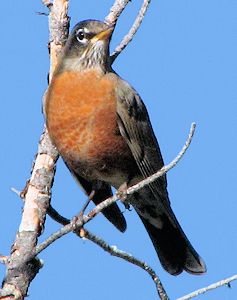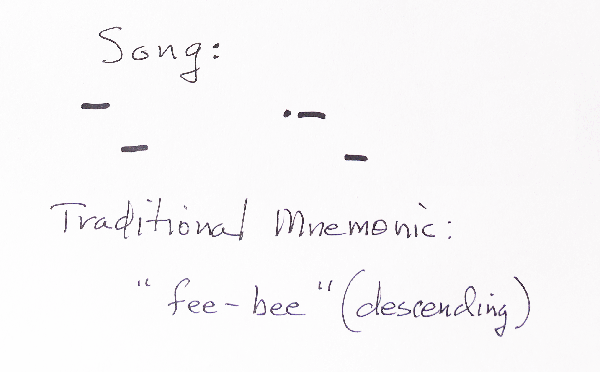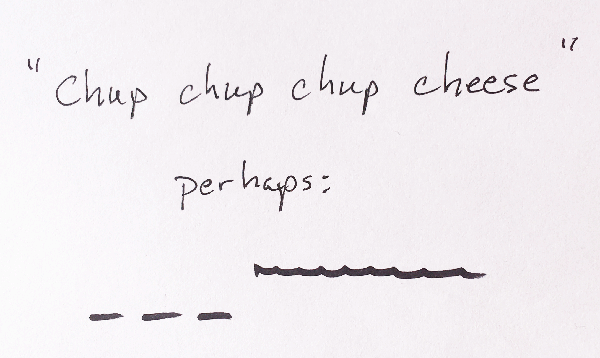Observing Birds:
Getting Outside! Getting into Nature!
Just stopping to look out a window and seeing a tree or a bird on the ground can change how one feels. Taking just a few steps out the front door adds sound to the experience. Taking a walk in the neighborhood or if you are lucky, along a stream or up a mountain path takes the change of feeling even further. Perhaps this is the essence of Bird-watching.
Slowing down. Letting the breath relax. It is an essential feature of bird-watching.
Walking Slowly Birds are constantly vigilant for predators. They will often fly for cover at the slightest sound or movement from a birder. People generally underestimate this effect. There are almost always birds in the bushes and trees around you, but it is often the case that the faster you walk, the fewer you will see. Of course, there are moments when a birders loud outburst or quick movement may flush a bird that would have otherwise gone unobserved. One's pace will vary with location, mood, companions and weather, but in general, slow is useful.
Slowing down is a preparation for Looking and Listening. In both cases, there are two styles of observing:
- One is less focused on details and more open to broad perspective on the whole scene. That shadow on the path of a bird flying behind you. A distant cry of a hawk. Cranes flying high almost out of sight.
- The second is focusing intently on the details of a bird down to each set of feathers or standing very quietly listening to a faint "tick-tick" offered every 20 seconds by a bird hidden in a nearby bush.
Usually both kinds of observing are happening at once. Observing the close details while not missing things happening on the broader landscape and vice versa. It all goes together: slowing down, focusing while staying open.
Being quietly observant.
The Wide View: Spotting Birds
Standing quietly, let your gaze "broaden" so that you are looking at the whole scene rather than having your focus on a single object. The human mind and eye are very good at perceiving movement and pattern against natural backgrounds.
If a bird moves, remain still and change your focus to the point of movement. If the bird is not immediately visible, don't be in a hurry. Keep watching the place where the movement occurred. The bird is probably still there. Sometimes a bird may be moving around inside a stand of willows or other shrubs. You may not be able to see the bird, but you will be able to see the branches shake as the bird moves from place to place. Eventually the bird is likely to become visible.
If you are walking, walk slowly and with the same kind of relaxed, "open" focus. Let your mind process the patterns.
Even a small songbird up high in the leaves can trigger a shift in your attention simply because it does not quite fit into the pattern of the leaves. A bird on the top of a Juniper on a mesa or on a rock along a ridge can be very apparent.
Once you can see the bird, keep your gaze right on it and slowly bring your binoculars into your line of sight. Slowly is important, because quick movements can cause even a distant bird to leave!
Birds in Flight:
The first impulse on seeing a bird in flight is to try to get the bird "in your binoculars". The result of this action is often not getting a "lock" on the bird and then not seeing where it landed.
Develop the habit of watching the bird until it lands.
Once it lands, mentally describe the location relative to the plants or trees or landscape where it lands. ("It's just to the left of the bright limb right in the middle of the tree.")
The Detailed View: Describing Birds
Once you have your binoculars focused on a bird, begin by describing what you are seeing.
What is the bird doing? Just how big is the bird? What are the main colors? What kind of a bill does it have: long & pointed, short & stubby? What kind of a tree or bush is it in? Or is it on the ground?The section on "How to Identify Birds" will go over what to look for in great detail. It is common for birders to name the bird as soon as they know what the species is. There is nothing wrong with that and if it's the 83rd Robin you've seen that day you're likely to just say "another Robin".
But in the beginning, the value of getting in the habit of describing rather than naming, even common species, can't be overemphasized.
Consider this bird:

Right away you could probably say that this bird is an American Robin.
But did you notice the split white eye-ring around the eye? Or the yellow of the bill?
- What if this bird was deep in a bush and all you could see was the eye and the bill?
Did you notice the white on the belly below its famous "Robin-red" breast?
- When seen flying fast overhead, that white becomes an important identification key!
What about the streaking on the throat?
The key to identifying species is usually found in the details.
It makes sense to cultivate the habit of describing those details!
We live in a very noisy world: automobiles, planes, motorcycles, chainsaws, ATVs, sirens, heating systems. We habitually tune-out sounds.
Birding offers the opposite experience: tuning-in to the sounds around us.
In the beginning, bird-watchers usually see birds before they hear them. But as you start to tune-in to the songs and calls of birds, that changes. Most experienced birders report that maybe 80 to 85% of the time, a bird is heard before it is seen.
Learning to recognize birds by their sounds, so called Birding by Ear, takes some time to develop. Studying recordings (readily available on the web) can help. That study coupled with experience in the field is an effective strategy. Eventually, you will see most species making their sounds. That helps to solidify one's learning.
As things progress, you will find that there is often a lot of variation in the details of a species' songs and calls. What is less variable is the tonal quality of the sounds. When your best friend calls up, it doesn't matter what they say. You know who is speaking. When your mother calls up, you don't have to ask if it's your mother.
When confronted with an unusual bird sound, it may take an experienced birder a while for the "tonal quality" to finally register and reveal the identification of the species.
The reality is that most of you are already familiar with many bird sounds. You have been hearing many of these sounds in your environment for years. You may be surprised to find how familiar some birds will sound once you begin to consciously listen. The overlapping of sounds, especially during the songful breeding season, can present a very complicated, confusing soundscape. As one begins to learn the sounds, the seeming "cacophony" begins to resolve into a beautiful chorus with one able to picture the hidden singers.
A Suggestion: Start with whatever you hear regularly near your home. Listen and quietly search for the bird. Seeing a bird making its sounds is probably the strongest source of learning. Even if you can't find the bird, take time to be with the sound. Describe what you are hearing. Quietly mimic the sound.
The section on "How to Identify Birds" will go over birding by ear in more detail.
Here are two of examples of Bird Sounds that are heard often in N. New Mexico:
Black-capped Chickadee
Here is a recording of one of the most common Black-capped Chickadee Calls. It is given in all seasons. Some suggest it says its own name. If you are in the proximity of a foraging group of Chickadees you are likely to hear it.
You can walk outside today at Rio Fernando Wetlands or near any feeder and likely hear this call.

Here is a recording of the Black-capped Chickadee Song. It is most prominent during the breeding season. In northern New Mexico it is commonly heard after the Winter Solstice and throughout the breeding season.
At a distance, you usually hear two notes. Up Close, you may hear a short note before the two principal notes:
Recording of Black-capped Chickadee Song:
Rio Arriba County January 12, 2008

Spotted Towhee
Here is a recording of a very common call note of the Spotted Towhee. You will usually hear this call coming from near ground level. At times, you might here only one call in ten minutes. At other times you might hear the call repeated consistently for minutes at a time.
The call above is given in all seasons, but the song (below) is associated with the breeding season. You are not likely to hear it in January or February, but by late March into early April, it is a very common song in the soundscape. In some areas it is one of the most prevalent song in the breeding season "morning chorus".
Recording of Spotted Towhee Song:
Rio Arriba County January 12, 2008
This species offers many variations of this song. The one given is typical in Northern New Mexico. It is sometimes remembered as "chup chup chup cheese.........", where the "chups" are single notes and the "cheese" is a trill:

It is not uncommon to hear as few as two "Chups" and as many as seven:
chup chup cheese... or
chup chup chup chup chup cheese... or even
cheese... chup chup
There are many variations of phrase. But the quality of the voice is the same.
A good way to enhance your observing experience, is to invest time at home studying your field guide. If you don't own a field guide, you can use this excellent online Field Guide: All About Birds (Cornell Lab of Ornithology). Here are a few study suggestions:
Visual Aspects:- Feather Group Names: Enhance your ability to precisely describe what you are seeing. Most guides have an illustration with these names.
- Family Groupings: Find similarities and differences between species within one family grouping.
- Difference between Sexes: Familiarize yourself with the differences between males and females of a particular species.
- Range Maps: Consult the range maps for a given family to get a feel for which species you are more likely to see in your location.
- Bill Shapes: Study differences in Bill Shape between different families.
Song and Sounds:
- On the All About Birds site, study recordings of the songs and calls of species you are regularly seeing.
- Try to mimic the calls or create sentences that remind you of the calls.
- Attempt to make graphic representations of the sounds: Dashes, dots, up-curving, down-curving and squiggly lines.
- Read descriptions of the songs and calls of a species in the Field Guide.
Learn more at: All About Birds: ID Skills
A common cycle in bird-watching:
- Look and Listen
- Describe
- Repeat from Beginning
- Consult References
- Repeat from Beginning
- Document
The same cycle with some notes added:
- Look and Listen: Notice the details of the bird and/or its sounds and of the habitat the bird is in.
- Describe: Silently or verbally describe everything in detail.
- Repeat from Beginning: The longer you look or listen, the more details will emerge.
- Consult References: A field guide (Print or Phone-based) or Bird ID Phone App (Merlin)
- Repeat from Beginning: The reference materials may suggest new details to look for.
- Document: Could include drawings of critical details and/or notations about the sounds. Could range from simply listing the Species Name (or 4-Letter Code) and the number seen, to prose or poetry describing the observation. If you are using the eBird Phone App, you might enter the data into your checklist.